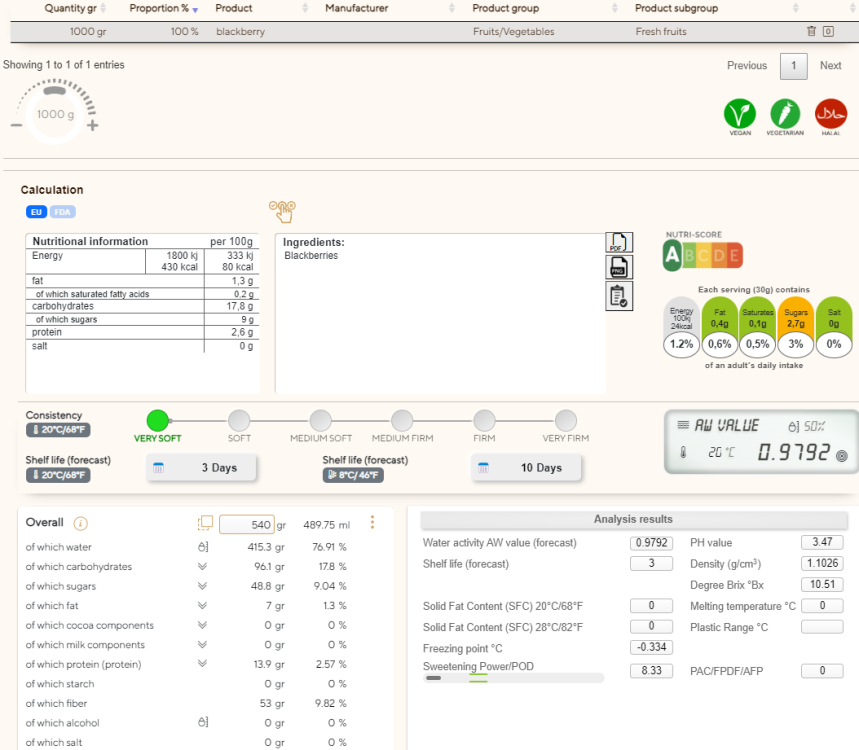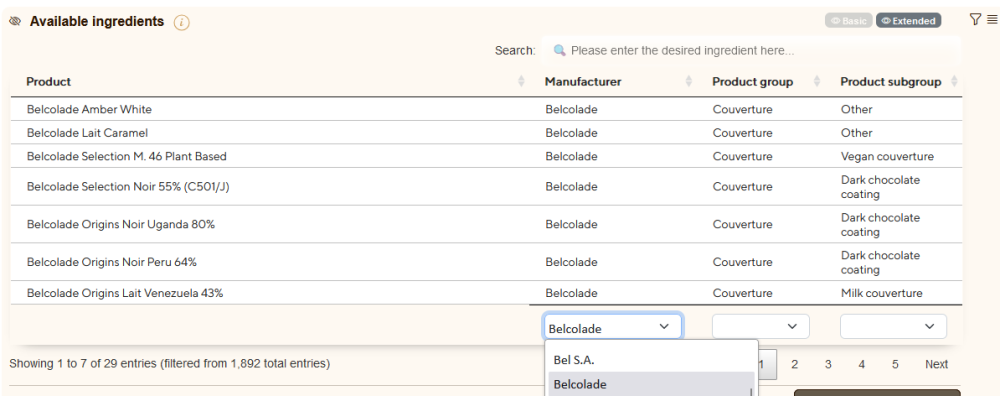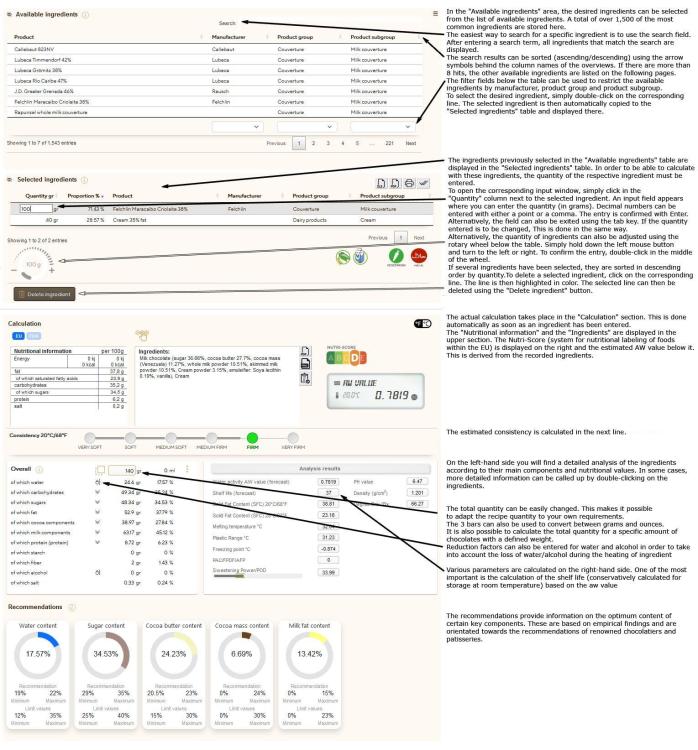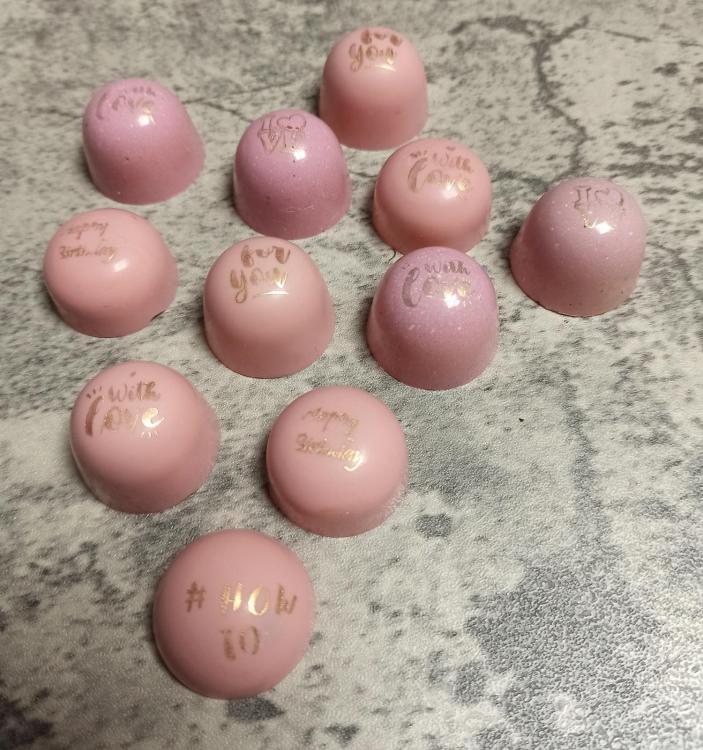
ChristianD
participating member-
Posts
14 -
Joined
-
Last visited
Recent Profile Visitors
The recent visitors block is disabled and is not being shown to other users.
-
I have calculated how high the aw value should be based on the ingredients of Heinz ketchup. This is at least the settled value of 0.89. I used the European recipe as a basis, which contains sugar instead of high-fructose corn syrup. This shows that the basic rule that the aw-value goes down as the sample sits is not applicable, at least not here. It seems that your device is not able to create uniform measuring conditions (temperature and humidity). Higher quality devices are capable of this. For example, any change in temperature has an influence on the aw value. If the ketchup comes out of the fridge, the aw value is initially lower. If the temperature of the sample rises, the aw value will also be higher.
-
Thank you for taking the time to test the calculator and for your detailed comments. First of all, it would be interesting and helpful for me to know whether you use a self-developed spreadsheet and which sources you use for the nutritional information. There is already an option in the current calculator to enter a water reduction factor. Admittedly, this is somewhat hidden. It can be accessed by clicking on the symbol to the left of the amount of water shown. I have now revised the functionality a little so that, in addition to a percentage water loss, you can also enter the result of a weight difference between the initial quantity and the reduced quantity. On this basis, I then calculated the composition of 540g (cooked) blackberries, reduced from 1kg initial quantity. The result is attached as a screenshot. I would need the exact recipe ingredients, including the quantities, to find out the reasons for the discrepancy between the spreadsheet and the website. It is correct that there is no option for the fat content. In my opinion, this is not necessary as there are various butter and cream products in the database. Even creams with a fat content of 40%. I will add butter with a fat content of 83% in the next days. In Europe, the fat content of butter is usually 80-82%. The fact that Callebaut 811 as chocolate and glucose 45 as sugar have an aw of 0 is of course not correct. I will make a correction here. I will also add a miso with a salt content of 5.3% to the database in the next days. In principle, it would already be technically possible for users to add new ingredients or edit existing ingredients. Theoretically, this would also provide an option for changing certain product aspects, for customising/adding local products. However, I have not yet activated this functionality, as only correct and complete information will lead to correct calculations. For example, the user would have to enter the pH value for each product, which could prove difficult in practice. I would also have to ensure the necessary translations. However, I would be happy to add additional products to the database on request. A short e-mail is sufficient. I will be happy to send you my e-mail address on request.
-
Thank you very much for the test and the positive feedback. I have just uploaded a version, which represents a first step towards improvement in UX/UI. The whole page is no longer displayed immediately (which may be too much for some users). Now is built up step by step depending on the input. Also some small design changes, which hopefully contribute to a better overview, have already been implemented. I will gladly take up the question regarding various temperature caramel as a ganache ingredient. I have already obtained some scientific papers on the subject. As a first step, I will probably implement a calculation method that calculates the water content, the Brix value and the aw value depending on the cooking temperature of the caramel. Other things could certainly be of interest here (e.g. the degree of sugar cooking, the caramelisation temperature depending on the composition of the sugar and possible milk components, etc.). Any ideas are welcome. With regard to the question of acidity. Yes, the acid/base content of a particular ingredient is actually taken into account. Or rather, the pH value is taken into account (as far as is known). This is stored in the database for many ingredients. For acids that are authorised under food law, the so-called pKa value is also stored. For sorbic acid this amounts to 4.76. When adding acid, this value is first used to determine the extent to which the acid influences the pH value of the aqueous solution (depending on the water content) using mathematical equations. Further mathematical models are then used to determine the effect of the different pH values of the individual ingredients and the resulting total pH value. This is finally shown under the item ‘PH value’. The pH value is currently only included in the shelf life calculation. But only when it falls below a certain value. Here I take into account the tolerance of certain microorganisms to low pH values. In the case of sorbic acid, however, only the pH value is taken into account and not the other antimicrobial properties, which are due to the inactivation of a number of enzymes.
-
I take a more nuanced view of the matter. For classic ganache recipes, which have a typical water and sugar content, I believe that in many cases the calculator is already almost as accurate as the measuring devices in the lower price range. This is due to the fact that the aw value of a ganache is largely determined by the type and concentration of soluble compounds in the water phase (e.g. NaCl, sugar, pH value). This means that the aw value of a classic ganache can be predicted relatively well by using linear regression equations. However, there are still significant deviations for products that deviate significantly from a classic ganache in terms of their composition (especially those with a water content of significantly less than 20% and a very low sugar content). This is due to the fact that an equilibrium moisture content with the ambient air is reached when the water content falls below a certain level (around 15-20%, depending on the material). As a result, the aw value drops significantly faster with decreasing water content. According to the calculator, wheat flour currently still has an aw value of 0.9 and therefore a shelf life of a few days. The realistic value, on the other hand, is 0.65 to 0.70. The same applies to nuts and nut pastes. I definitely need to improve the calculation here. The sentence ‘AW isn't something that's digital. You can measure a sample 10 times and you won't hit the exact same value each time.’ is for me the best example of why a digital value makes sense. Many environmental factors (temperature, humidity, air pressure, etc.) play a role when measuring with a measuring device. Although high-quality devices try to compensate for these factors as far as possible, this will probably never work completely. This leads to deviating results with the same samples. In addition, different food products show different aw change when the general conditions are changed. For example, a study showed that wheat flour strongly increased its aw as temperature increased, while fat-rich peanut butter decreased its aw under the same temperature change. If there are specific examples of ganache recipes where the current results are not too accurate, I would be happy to receive them 😊. This would enable me to investigate the causes and correct them if necessary.
-
Ah, now I understand the confusion. I must have contributed to it myself 😌. The ‘Enter new ingredient’ button is only intended if you want to add an ingredient that is not yet in the ingredient database. There are already around 1,900 ingredients with all the relevant parameters stored there, which cover most standard recipes. You can search for ingredients in the database using the search field (see screenshot). As soon as a search term (or parts of it) is entered here, all ingredients already stored in the database that match the search are displayed.
-
Thank you for the questions. They help me to understand where there may still be uncertainties. How do I change the temperature for the shelf life estimate? Should the shelf life estimate in days in the example above represent a shelf life of 10-36 days? The 2 values of the shelf life estimate should represent typical storage conditions. The first value (20°C) represents storage at room temperature and the second value (8°C) should represent storage in the refrigerator. The temperature for the first value cannot be modified. The temperature for the second value can be adjusted individually (between -25°C and 32°C). The value ‘8’ can be overwritten here. A recalculation should then take place (I hope the functionality works in all browsers). Is there an easier way to search for ingredients, e.g. entering Becoldade in a search box and displaying all Belcolade products as a clickable list? Yes, it is possible to search for ingredients (e.g. Becoldade). When you enter a search term in the search field, all entries in the database that match the search criteria (i.e. are contained in one of the fields) are displayed. The more precise the search term, the more exact the search result (case insensitive). If more than 7 hits are found, only the first 7 hits are displayed on the first page. To see the other entries, you can click through the other search results using the number fields on the right below the ingredient table. For example, a total of 29 entries are found for the search term ‘Belcolade’. You can of course narrow down the search further by expanding the search term (e.g. Belcolade white). Then only the white couvertures will be found (4 entries in total). Another way to display only the products of a manufacturer, a product group or a product subgroup is to use the drop-down fields in the corresponding columns below the table. If you select a specific entry here (e.g. Belcolade in the Manufacturer column), only products from Belcolade are displayed. Where is glucose? Simply enter the term ‘Glucose’ in the search field. There are currently 12 products in the database (glucose, glucose syrup powder and glucose syrups with different DE values) Missing translation - manufacturer? What exactly do you mean here? Is a table heading incorrect? I have deliberately not translated the manufacturer names in the table, as these do not usually vary depending on the language.
-
Thanks for the honest feedback. It shows me that there is still a lot of room for improvement in terms of UX/UI. At a certain level of complexity, no software product is likely to be completely intuitive, but I was hoping that the operation would be more self-explanatory. Therefore, in the first step, I added or extended some help texts and changed the shape of the cursor in certain places. Sooner or later, however, I will probably have to create a tutorial to make it easier for newcomers to get started and to describe all the features. I have also already corrected the missing translations that I noticed. Regarding the missing aw calculation, I assume that the quantity information for the selected ingredients in the ‘Quantity gr’ column was not finalised. This must always be confirmed with the Enter or Tab key. Only then is the entered value accepted and included in the calculation. I have attached a screenshot of how it should look in the end.
-
Hello, At the end of May 2024, I first mentioned my online ganache calculator here in the forum. At the time, it was suggested that I start a separate thread for this, which I am happy to do now. Anyone who is familiar with ganache fillings knows that they are the result of carefully matched ingredients and their harmonious interaction. My ganache calculator should help you to perfectly balance the ratio of your ingredients and thus achieve the best possible result in terms of consistency and shelf life. Originally based on an Excel file, I quickly realised the limitations of Excel and decided to develop a calculator based on a modern web interface. Admittedly, there are already software products on the market with a similar approach. However, I missed certain functions in these products. The current test version of the calculator in English can be found at http://www.ganache.guru/Test_En.php The calculator is designed to help chocolatiers, pastry chefs, and food enthusiasts create the perfect chocolate ganache every time. Via easy-to-use interface, you can simply input your recipe ingredients and quantities and it will directly and on-the-fly calculate all relevant key figures. It also provides information on the optimum content of certain key components. These are based on empirical findings and are orientated towards the recommendations of renowned chocolatiers and patisseries. A special feature is that the aw value can be estimated with high accuracy even without expensive measurement technology. The aw value is an important indicator for the shelf life. Together with parameters (e.g. pH value and alcohol content), it is used to determine the minimum shelf life. Each time the ingredients are changed, a recalculation is performed automatically. This makes it possible to customise your creations, allowing you to adjust the sweetness, richness, and texture of recipes to your exact specifications and adapt recipes specifically in the direction of a long shelf life. Whether you're creating a ganache for sliced chocolates or a filling for hollow moulds. It takes into account all decisive physical properties of each ingredient, ensuring accurate and consistent results every time. So you can easily balance your creations and scale up or down your recipes, according to your individual requirements. This saves time, reduce waste, and improve the consistency of your chocolate ganache recipes. Try it for free and experience the difference for yourself! I have tried to make the operation as self-explanatory as possible. If you have any questions, I will be happy to answer them and provide a quick guide if required. I would be very pleased to receive your feedback. Constructive criticism and requests for optimisation are also very welcome. If you are missing a certain functionality or a certain ingredient, please let me know. Other languages can also be made available if there is sufficient interest. Note: The calculator is still in the development phase, so I cannot guarantee that it is completely error-free... 😉
-
@Kerry Beal @Jim D. There is a formula for calculating the maximum water content in a boiling sugar solution. This is 5.06+EXP(16.54-(0.13* boiling temperature ) This is already integrated in my calculator (although at the moment it has no influence on the amount of water displayed). So with an initial quantity of 1000g sugar and 500g water at a boiling point of solution of 150 degrees Celsius, the maximum water content is 5.11%. This means that only a little more than 25g of the original amount of water would be left. Of course, the calculation becomes more difficult if additional liquid (e.g. in the form of cream) is added while the mass is still above the boiling point of water. It should also be noted with sugar solutions that the quantity in ml differs significantly from the quantity in grams, as sugar has a relatively high density.
-
@Rajala Thank you very much for your feedback. I have no problem at all with constructive criticism, as long as it is formulated objectively. Appropriate feedback is essential in order to point out possible weaknesses. According to current plans, there will be 3 variants (Basic, Standard and Premium). The Basic version will remain free of charge. Small monthly fees should be charged for the Standard and Premium versions. Personalised support and some other features will be reserved for the Standard and Premium versions. The judge the consistency is based on the fat and other dry ingredients (protein and cocoa solids, etc.) and compares these to the liquid ingredients (water, alcohol, oils). The solid fat content (SFC) at 20°C is also included in the calculation. This is based on an analysis of the triglyceride (TAG for short) and also takes into account (as far as possible) the eutetic behavior of fat mixtures. The sugars are not yet included in the calculation, although I am of course aware that long-chain sugar molecules in particular (e.g. in glucose syrup) do have an influence on the consistency. Water activity can be estimated by different theoretical and empirical models. I started with the Grover Equation and the Norrish Eqaution. However, I was not really satisfied with the results. After studying various scientific papers, I started to develop my own mathematical model. This is based on the realization that mainly the water content and the content of humectants (i.e. substances that are able to chemically bind water molecules) play a significant role in the aw value. These are mainly salts, sugars and sugar alcohols. For all of these substances, I have determined the binding capacity of water molecules from scientific studies and determined a mathematical model for calculating the influence on the aw value in each case. It should be noted that the influence is generally not linear but curvilinear. The other solids content (proteins etc.) is also included in the calculation. Fats are not taken into account here because, as far as I know, they have virtually no influence on the aw value. Theoretically, the sorption isotherm should also be included in the calculation. However, this can hardly be calculated mathematically for a complex system such as a ganache. I have repeatedly compared the results obtained with real results. Of course, there were certain deviations. However, at least with classic ganache recipes, these were well below 10%. Therefore, some examples with significant deviations from the values you measured would be very helpful.
-
@Kerry Beal Thank you very much for your kind words. Briefly about myself. My name is Christian Dante and I come from Germany. I am not a trained chocolatier or patissier, but rather came to the subject of chocolate and pralines by chance about 15 years ago. I was fascinated by the subject from the very beginning. Back then, social media was still in its infancy, so I learned a lot of things on my own. On my journey into the world of chocolate, I have already met many well-known chocolatiers and chocolate experts and my expertise is now often in demand, at least in German-speaking countries. Interestingly, I did my first and only chocolate course (as a pupil) at "Törtchen,Törtchen" in Cologne, whose founder Torsten Schöneich (schneich) created the first version of the Excel spreadsheet "Balancing your Ganache Recipes 2.0" (https://forums.egullet.org/topic/114561-balancing-your-ganache-recipes-20/) here in the forum, which was also the very first approach for my calculator. Initially, my calculator was also based on Excel, but over time I realized the limitations of Excel and decided a few years ago to port the whole thing to a modern web interface. Initially, the reactions were somewhat sceptical, as there were already two programs on the market, Ganache Solution and Pro-Choc. I got to know Ganache Solution in real operation for the first time in 2019 at a meeting with Ramon Morato. In principle a good program, but I was missing some important features, the program was not available in German and the price was still quite high at the time. In the last 2 years I have been working more intensively on the calculator and the software and database behind it. During this time, I have also dealt intensively with the subject and studied virtually every scientific paper from the last few decades that touches on the subject. Since as I have a normal full-time job and am doing all the programming myself (one-man project), the project is not progressing as quickly as I would like. In the meantime, however, I have reached a point where the basic concept is in place and the calculator is sufficiently stable. However, I don't want to rule out the possibility that there may still be a bug or two 😉. My aim is to create a calculator that performs fairly complex calculations in the background, but is still relatively easy and intuitive to use, even for beginners. I would be happy to open a separate thread for this so the topic gets a little more attention. However, this may take another 2-3 weeks due to vacations. To make it a little easier to get started, I have attached a screenshot with explanations. In this context, I have initially hidden all buttons that have no influence on the actual calculation.
-
I would like to take this opportunity to refer you to the test version of my ganache calculator, which you can find at http://ganache.guru/Test_EN2.php. It offers a range of calculation options, provides recommendations and is able to perform a variety of parameters (including consistency and shelf life) based on the ingredients. This may help balancing recipes for truffles. One of the biggest advantages is that most of the common ingredients (currently about 1500) are already stored here and do not have to be entered manually. If certain ingredients are still missing, you are welcome to send them to me. For any questions and/or requests, please do not hesitate to get in touch. If you have any suggestions regarding additional functionality or if you are missing functions, please feel free to let me know. I will gladly try to implement them.
-
The same question was asked a few weeks ago. I once carried out a test with stamps. As soon as I find the time, I will publish a tutorial in the Facebook group "https://www.facebook.com/groups/1413728595685917".












